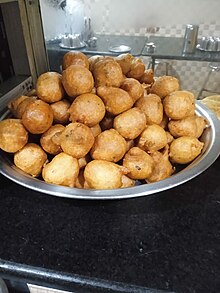 | |
| Alternative names | Mangalore bajji |
|---|---|
| Course | Breakfast |
| Place of origin | India |
| Region or state | Tulunad, Karnataka |
| Main ingredients | Maida, curd, gram flour, rice flour, onion, coriander leaves, coconut, jeera, green chillies, ginger |
Golibaje (in Tulu) or Mangalore bajji (in Kannada) is an Indian fried food made from various flours and curd. In the Tulu Nadu region, it is known as golibaje. Other names for the dish include Mangalore baje.[1][2] This is widely famous in Andhra Pradesh and Telangana as Mysore bonda/bajji.[3][4][5][6]
Ingredients[edit]

The main ingredients used to make Mangalore bajji include maida, curd, gram flour, rice flour, chopped onion, coriander leaves, coconut, jeera, green chillies, curry leaves, and salt. The ingredients are thoroughly mixed to form a hard batter, then shaped into a small ball and deep fried, preferably in coconut oil. It is often served with chutney.
Serving[edit]

The dish is usually served warm with coconut chutney .[7]
See also[edit]
References[edit]
- ^ Kamila, Raviprasad (9 September 2021). "Buns and goli baje from paper pulp". The Hindu. ISSN 0971-751X. Retrieved 8 January 2022.
- ^ "Street food 'Goli Baje' steals heart of foodies". English Archives. 17 November 2021. Retrieved 18 April 2022.
- ^ "Mysore Bonda Recipe, Mysore Bajji Mangalore - Yummy Indian Kitchen". 12 July 2016.
- ^ "Mysore bonda". 5 February 2019.
- ^ "Mysore Bonda Recipe | Mysore Bajji". 7 August 2021.
- ^ "Mysore Bonda - Manjula's Kitchen - Indian Vegetarian Recipes". 30 January 2015.
- ^ "GOLI BAJE / MANGALORE BAJJI RECIPE / MANGALORE BONDA". Cook with Smile. 6 November 2014.



Well, that’s interesting to know that Psilotum nudum are known as whisk ferns. Psilotum nudum is the commoner species of the two. While the P. flaccidum is a rare species and is found in the tropical islands. Both the species are usually epiphytic in habit and grow upon tree ferns. These species may also be terrestrial and grow in humus or in the crevices of the rocks.
View the detailed Guide of Psilotum nudum: Detailed Study Of Psilotum Nudum (Whisk Fern), Classification, Anatomy, Reproduction